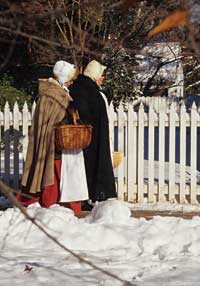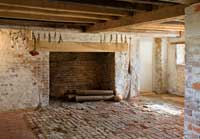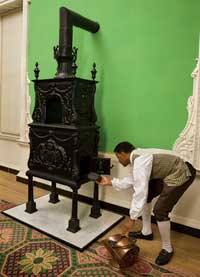Page content
Coping With Cold
by David Robinson
photos by Dave Doody
Online Extras
A Williamsburg Winter Slideshow


Cloaked against a sunny chill, two costumed interpreters follow a path through the remains of a Williamsburg snowfall.

Cordwood stacked near colonial homes and buildings—here Colonial Williamsburg’s Golden Ball—feeds Historic Area fireplaces.

The size of the basement kitchen fireplace at seventeenth-century Bacon’s Castle in Surry County suggests its appetite for fuel.

At the Governor’s Palace, interpreter Brandon Hewitt feeds coal into an example of a Abraham Buzaglo heating stove.

At Valley Forge, Continental soldiers weathered their worst winter of the American Revolution in earth-fast cabins such as these.
Wrote Thomas Jefferson in 1805: “The Canadian glows with delight in his sleigh and snow; the very idea of which gives me the shivers.” Was the president recalling that January night in 1772 when he spirited his pretty bride, Martha, away from two weeks of wedding revelry at her family’s estate—and out into a blinding snowstorm? When their cozy phaeton bogged down, they shivered the last eight miles to Monticello on horseback, scrambling up his “little mountain” through two-foot drifts in the dark. They got a cold welcome; the servants had banked the fires and gone to bed. Finding a half-empty bottle of wine, they warmed a little outlying cottage—the domed mansion was still but a dream—with “song and merriment and laughter.” It was, he wrote next day, “the deepest snow we have ever seen.” Coping with cold may not be much of a challenge for young newlyweds. But for most American colonists, winter could be anything from inconvenient to challenging to deadly.
The Mayflower settlers stepped ashore at Plymouth in December, too late to prepare for even a relatively mild, wet winter like the one that tried their souls in 1620–21. By spring, half those souls had left their bodies in the ground. “They that know the winters of that cuntrie know them to be sharp and violent,” wrote Governor William Bradford, “and subjecte to cruell and feirce stormes.” Winters were milder at Jamestown, but still took a heavy toll. The Virginia winter of 1609–10 was their “starveing Tyme.”
By the 1700s, proper houses had replaced the rude huts and cabins of earlier days. Dwellings of the well-to-do merchant and planter would have fireplaces, sometimes in every room, served by one or two chimneys at each end of the house or by a single great stack in the center. A fireplace gives but takes away; much of its heat goes up the chimney and pulls cold air into the house to replace it. Ethan Allen built a fire one wintry noon to heat up his Vermont house for an evening meeting, but by then, it had warmed to only 53 degrees.
Jefferson would have settled for such comfort when he wrote to a friend, “It is so cold that the ink freezes in my pen.” Virginian Landon Carter’s 1770 diary reports that, even in April, water froze in his washbasins. And as late as June, Philip Fithian, tutor to the Carter children, wrote of “a good Fire in the Dining-Room, and it seems as necessary & agreeable as in November or December.”
Then came January. “Mr Carter has a Cart & three pair of Oxen which every Day bring in four Loads of Wood, Sundays excepted,” Fithian wrote. “And indeed I do not wonder, for in the Great House, School, House, Kitchen, &c. there are twenty Eight steady fires! & most of these are very Large!”
Simpler houses, and the detached kitchens of the great plantations, had but one fireplace, a huge bay of brick or stone a person could walk into. The kitchen of Stratford Hall, the Lee mansion on the Potomac, has a fireplace twelve feet wide; you could roast an ox whole in it. The appetite of one of these fireplaces could clear an acre of woodlot in a year. Early ones burned fore-logs and backlogs so huge they sometimes had to be dragged into the house by horse and chain. Hardwoods were felled first because they burned best, but hard or soft, all left soot in the chimney. Short stacks could be cleaned out with a brush; for taller ones, you could drop a couple of chickens down the flue and let their frantic flapping do the job.
The demands of winter cast a long shadow before them, well into the waning summer. Mothers taught daughters how to card wool and coax soft fibers from the hard stems of flax; how to spin fibers into threads; how to stitch and mend the heavy coats and hooded cloaks that soon must ward off the biting winds. Cloth scraps and worn-out clothing found new life in quilts and coverlets. Finer stuff went into quilted petticoats to keep a lady warm.
Fruits were dried in the summer sun. Apples gained longevity when pressed into cider or cooked into applesauce or apple butter. Cucumbers and other vegetables were pickled. Meats and fish were salted or smoked. Such root crops as turnips, parsnips, and carrots kept well in a root cellar, usually a below-ground dugout that kept them cold but not freezing. Seeds were plucked from autumn’s bounty and carefully stowed for spring planting. Even the falling leaves were gathered and strung on sticks by the children to serve as under-liners for bread as it baked on the hot hearthstones.
Piles of firewood were cut and stacked in the warmer months for heat in cooler times and for cooking year round. Corncobs were saved for smaller fires, or for an extra touch of flavor in hams and bacon smoked over them. If the fire went out, flint and steel could spark a new one, or a child could scamper to a neighbor and bring home a hot coal in a cook pot or a tray of green bark.
At Colonial Williamsburg, tradespeople shape wet clay into bricks for drying during summer, and firing for five days and nights in the chill of October. To Jefferson’s chagrin, “The unhappy prejudice prevails that houses of brick or stone are less wholesome than those of wood.” True, in winter, moisture condensed on masonry’s cold interior walls, but if you kept a small fire crackling in the room, the problem went up in smoke. Monticello, then and now, stands wholesome in its russet walls of brick baked on the site.
Jefferson’s honeymoon notwithstanding, winter could be good for a road. After the rains of autumn, a hard freeze turned its muddy quagmire into a firm pavement for a wagon. A good snowfall paved it well for a sledge, and a rip-snorting snowstorm obscured the roadway entirely and allowed sledge or sleigh to cut cross-lots. City folk turned out with shovels in mittened hands to level the snowdrifts for sleighs—and for customers to reach your door if you were a shopkeeper. Country folk hitched oxen to a plow to “break out” the long country roads. And everywhere, children zipped downslope on sleds, some with runners made from saplings curved by nature.
Rivers and bays were the real highways of the colonies, bearing boats in summer—and sometimes wagons in winter. “We are credibly informed,” said a January 22, 1780, item in the Virginia Gazette, “that six loaded waggons went over James river, on the Ice.” On February 5: “Several persons have gone from Annapolis, to . . . Baltimore town, on the ice, and are crossing to and from Kent island every day, which has not been known . . . we believe, since the memory of man.” But on January 28, 1737, Williamsburg’s newspaper had sounded a more sobering note. “The Weather has been so excessive bad, for some Time past, that there has been scarce any passing the Rivers, for Ice, or travelling for Snow.” It told of “Persons being frozen to Death, and others drowned, by attempting to cross the Rivers. No Post has come from the Northward these 6 weeks; and we may reasonably conclude, that as the Weather is so severe here, it is worse there.” No doubt it was.
Ice-hardened roads served George Washington well as he repositioned his artillery by the Delaware River. Not so at Valley Forge, where the winter of 1777–78 froze the deep ruts of farm wagons into ragged ridges that tore at the soldiers’ feet—some in makeshift moccasins, some bare and bleeding—as General Washington marched his army toward a long winter of discontent. Promised supplies never came; foodstuffs arrived rotten or waterlogged. A shipment of coats came, but the supplier had omitted the buttons that would close them tight against the wind. Soldiers made crude footwear out of untanned animal skins or anything else that would do. Assigned to guard duty in the snow, a shoeless man could only stand on his hat and shiver.
The first work party ashore from the Mayflower got busy building shelter. Washington’s men did the same. On Mount Joy—ironically, a Mount Misery rises nearby—crews of about a dozen men each built themselves a hut of logs and got a fire of green wood going in a rough fireplace at one end. But if they opened the makeshift door at the other end to let the choking, eye-stinging smoke out, the warmth went out with it as the frigid wind sliced inside. Cold drafts found their way in anyway, blasting down the chimney or knifing through the clay and splinters stuffed haphazardly between the logs.
It was the best they could build; the British had torched the sawmill nearby and deprived them of boards. The men worked “without nails or tools,” wrote Colonel Henry Livingston, who supposed he and his men might “render ourselves very comfortable by the time winter is over.” Another officer moved into a cave that a farmer was using as a springhouse, a small shed built over a cooling spring.
A few huts of log or stone, some original, some replicas, stand in a state park at Valley Forge today. Each is a mute testimonial to the toughness and determination of men who stayed while thousands gave up and left.
Some of the Dutch settlers along the Hudson River knew how to heat a house. In what would have been a fireplace stood a great metal box that was a stove; some piped warm air to a radiating drum on the second floor. Trouble was, this built-in stove opened on the outside; you had to bundle up and plunge into winter’s worst to keep stoking the fire. Benjamin Franklin had a better idea. In 1742, says his autobiography, he “invented an open stove for the better warming of rooms. . . . Gov’r. Thomas was so pleas’d . . . that he offered to give me a patent.” The free-standing “Franklin stove” would have made him a fortune, but instead the man who extolled a penny saved gave his idea to the world—and watched others make money producing it.
For size and ornamentation, nothing quite matched the “Master piece” of London iron founder Abraham Buzaglo, a ponderous stove with lions, pineapples, Grecian urns, pagodas, and swags of blossoms cast into its three-tiered iron shell. Nothing quite matched Buzaglo’s pride in it, either. “It excels in grandeur any thing ever seen of the kind,” he wrote, “and could not be sufficiently admired.” At a price that would have paid his aide for three years, Virginia Governor Norborne Berkeley, Baron de Botetourt, ordered the ponderous piece for a gift to the House of Burgesses, but he died two months before its delivery in December 1770. A decade later the government, and the noble stove, moved to Richmond, where it gradually became just another old fixture, a place for lawmakers to roast peanuts and chat. Now it is back at Williamsburg, warming the hearts of admirers who study this triumph of the iron master’s art.
No matter how cozy the cabin or Capitol, there were times when one simply had to venture out the door. Thankfully, there were ways to avoid a shivery but necessary trip to the necessary, that little house out back with its icy seat and drafty door. Chamber pots postponed the excursion for highborn and humble, and sometimes evoked a smile to lighten the dreary day. If your revolutionary fervor ran high, you might order one with His Majesty King George’s portrait in the bottom. Most of them being ceramic, though the better ones were pewter, the “thunder jug”—so called for obvious reasons—was as breakable as it was indispensable. Washington ordered them a dozen at a time, plain white, as befit so genteel a home as Mount Vernon. Maryland’s Charles Carroll was more specific, if less egalitarian: “24 white stone chamber potts,” he ordered for Carrollton in 1772, along with “24 strong coarse do for servants.” By “do” was meant “ditto.”
The year’s first harvest came not in summer but in February or March, when nights below freezing and days above brought maple sap up from the roots and out through tubular spiles to drip into buckets hung waist high or a dugout trough on the ground. Twenty or thirty gallons would boil down to one gallon of syrup. Boiled further, it crystallized into maple sugar, a favorite sweetener, as was wild honey, in days before cheap sugar poured in from the Isles of the Caribbees. A good run of sap would last several days, ending in a revel in the woods with wives and girlfriends joining in the celebration. “Sugaring off” was, and still is, a Yankee tradition, but even in Virginia, planter and historian Robert Beverley in 1705 could appreciate “the Sweetness of it being like that of good Muscovada,” a purified raw sugar from Barbados.
As summer prepared for winter, so winter’s chores presaged the coming of summer. Old tools were repaired and new ones made. Wood under a jackknife became a ladle, a tool handle, a new tooth for an old rake. Fats from cooking were carefully saved; ash brushed from the hearth with a turkey wing was stored, perhaps in a bucket made from a single cylinder of birch bark. In spring, the two would meet in the laborious chore of making lye soap.
Farmers could keep milk for perhaps a week in a cold creek or in a springhouse. At Williamsburg, slabs of ice were cut and stacked on edge in an icehouse; there is one behind the Governor’s Palace, and there once was another at Jamestown. Up north where foot-thick ice was common, it was stacked in big blocks that took longer to melt. Well insulated with straw and sawdust and shaded with trees, a good icehouse could serve as a cooler for butter, milk, eggs, and other perishables well into the coming summer. This writer fondly remembers sneaking into his grandfather’s icehouse to cool off on a hot summer day—and, less fondly, the time he caught me and I could not sit down until the morrow.
“For summer being done,” wrote Pilgrim Governor Bradford, “all things stand upon them with a wetherbeaten face; and the whole countrie, full of woods and thickets, represented a wild and savage heiw.” On the last day of September 1774, Fithian wrote that “We have now entered on the Winter plan, have Coffee just at evening & supper between eight and nine o-Clock.” Between Bradford’s terrible lament and Fithian’s casual footnote stretched a century and a half of trial and triumph as a hardy new people learned to cope with cold.
A retired National Geographic book editor, David Robinson writes and photographs from his home in New England. He contributed “The Bugs that Bugged the Colonists” to the autumn 2007 journal.



